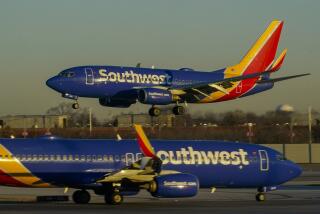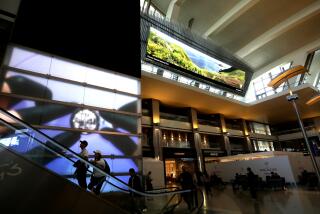Airport Noise Battle Roars Back to Life at John Wayne : Regulations: Proposed changes in takeoff procedures would make it quieter over some areas but louder over others. Pilots say already scary airport would become more hazardous.
COSTA MESA — A proposed change in takeoff procedures at John Wayne Airport could pit some neighborhoods against others and compromise a 1985 court settlement, residents say.
If the changes are implemented, jets would be higher and thus quieter over Balboa Island, while Santa Ana Heights homeowners might experience more noise from pilots’ use of more thrust less than a mile from the runway.
Anti-noise activists also said the change could undermine the 1985 court settlement that allowed the airport to expand in the first place. The hard-won settlement ended a decade of lawsuits and was based partly on maintenance of the nation’s toughest airport noise rules and limiting the new terminal to 8.4 million passengers annually.
Airport officials fear that under the proposed change in takeoff procedures, the McDonnell Douglas MD-80 jetliner might not pass the airport’s existing noise standards, forcing the county to ban it. Without any MD-80 flights, jet noise would be reduced in the surrounding community.
“Lots of people would be happy” with no MD-80 flights, said Barbara Lichman of the Airport Working Group. “But then the FAA (Federal Aviation Administration) could argue that the airport is wrongfully restricting access by the airlines, and that’s not a good trade-off” because the FAA might order the airport to stop regulating such aircraft altogether.
What prompted this concern is Wednesday’s vote by an aviation advisory group to seek a ban on the practice by airliners taking off from John Wayne Airport to cut back power at 500 feet, a strategy aimed at reducing noise over nearby homes. The air carrier operations subcommittee, which has members from organizations representing pilots, airlines, aircraft manufacturers and airport owners, told the Federal Aviation Administration that the cutback should be changed to 800 feet.
In an effort to appease John Wayne Airport officials, the group also proposed that the FAA study the environmental impact of the proposed change, but urged the agency not to wait until the results are known.
Pilots have mounted an all-out attack on both the cutback and the airport’s steep takeoff angle of 23 degrees or more as dangerous, despite previous FAA and airline assurances that the procedure is safe. The subcommittee meeting in Washington did not take up the issue of the takeoff angle.
Once considered a highly technical debate, the controversy has spread to the general public because of a recent segment of ABC-TV’s news show “20/20” in which pilots ranked John Wayne Airport among the five in the United States they fear flying out of most.
Airport officials argue that it was the airlines which first designed the takeoff procedure and it is the FAA that administers it, not the airport. But airlines argue that they were under pressure to come up with a way to meet the airport’s noise standards. Without the power cutback at 500 feet, for example, the McDonnell Douglas MD-80, currently the noisiest passenger jetliner serving the airport, probably would not meet standards at John Wayne.
Newport Beach Councilwoman Jean H. Watt, who lives under the flight path just west of Balboa Island, said the proposed change could pit neighborhoods against each other.
“It’s schizophrenic in that it could be better for people on Balboa Island and worse for the people in certain areas, and I don’t know what the home purchase assurance program will be like for those people,” Watt said.
Earlier this month the Board of Supervisors froze a home purchase and acoustical insulation program for areas closest to the runway until studies determine if the proposed cutback change will change which homes qualify and at what cost to taxpayers.
“It’s schizophrenic in another way,” Watt added. “Because you also have people in both neighborhoods, who besides being concerned about noise are also concerned about safety.”
Santa Ana Heights resident Edwin C. Hall is a case in point.
“Quite frankly, the FAA must have known from the very start that this ill-conceived 500-foot roller-coaster departure practice was unsafe,” Hall said. “As a matter of fact, so is 800 feet. . . . It’s best to be alive and have no hearing ability than be dead.”
Airport officials visited Washington last week in a bid to win FAA assurances that if the county and other parties to the 1985 court settlement agree to change current noise limits in order to accommodate the 800-foot cutback, the FAA would not force additional, noisy flights on the county.
Altering the noise standards “would not be politically popular with citizens around here, but it might save the 1985 agreement,” Lichman said, “and that’s paramount.”
But the FAA so far has refused to give such assurances.
Reps. Christopher Cox (R-Newport Beach) and Barbara Boxer (D-Greenbrae) have scheduled the second of two local hearings on national airport noise policies for Aug. 15 in Newport Beach.
More to Read
Inside the business of entertainment
The Wide Shot brings you news, analysis and insights on everything from streaming wars to production — and what it all means for the future.
You may occasionally receive promotional content from the Los Angeles Times.










